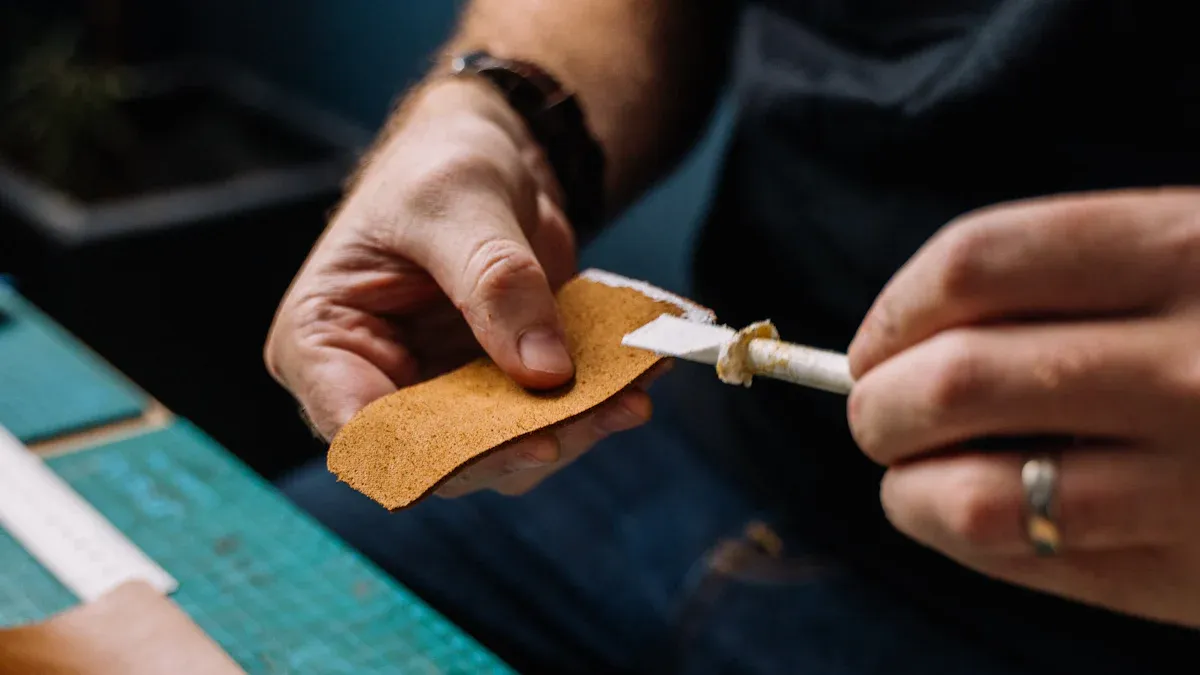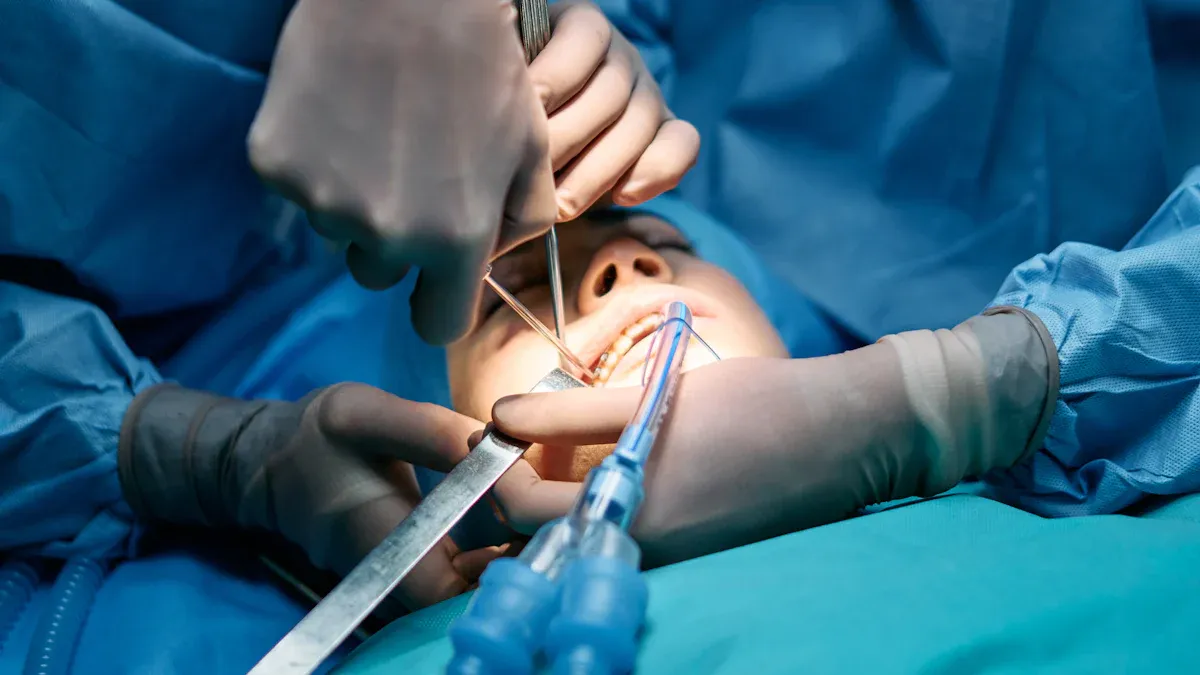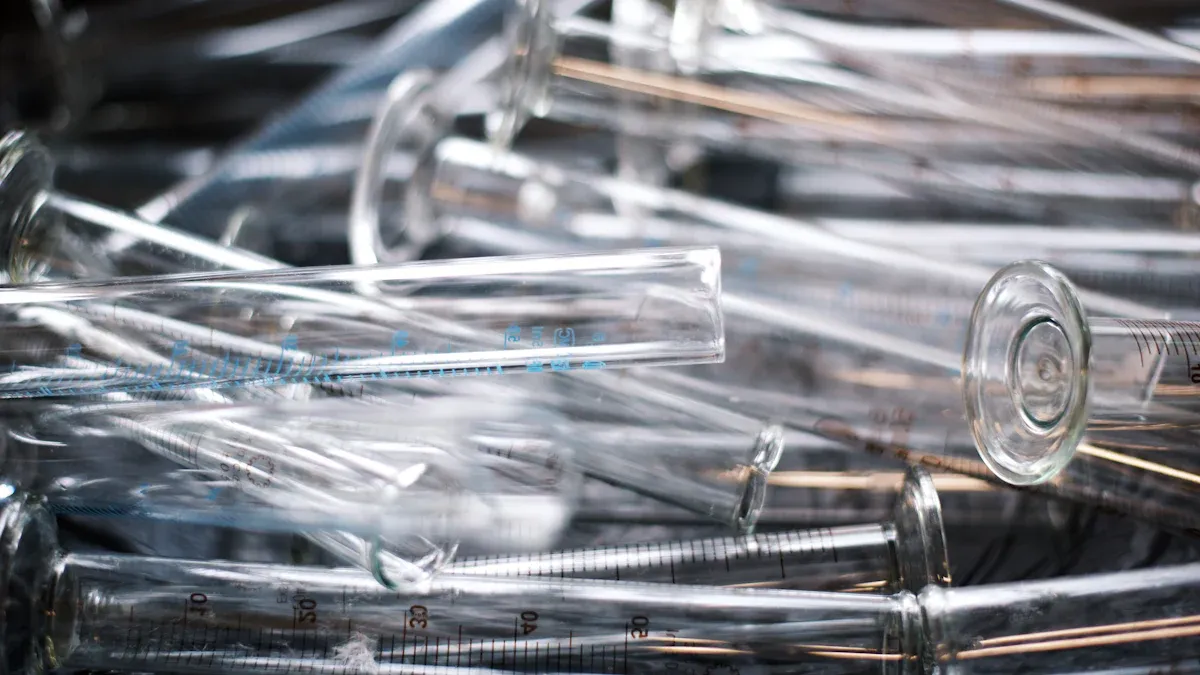How to Use Heat Shrink Tubing for Catheter Production

Heat shrink tube for catheter manufacturing plays a pivotal role in the production of catheters, driving advancements in precision and reliability. Manufacturers rely on its ability to create smooth surfaces and secure bonds during processes like reflow bonding and tip forming. These features contribute to the growing demand for high-performance catheter systems, which offer flexibility and compatibility with imaging technologies. The global market for medical-grade heat shrink tube for catheter manufacturing, valued at approximately USD 200 million in 2023, reflects its importance in supporting innovations in minimally invasive procedures and intricate device designs.
Key Takeaways
Heat shrink tubing makes catheters more accurate and dependable. It creates smooth surfaces and strong bonds for patient comfort.
Picking the right heat shrink tubing is very important. Think about material type, shrink size, and fit for best results.
Lining up the tubing correctly when heating stops mistakes. This helps it fit tightly and improves catheter quality.
Use controlled heat carefully with hot air guns or ovens. This spreads heat evenly and keeps the material from getting damaged.
Careful quality checks make sure catheters follow strict medical rules. This keeps patients safe.
Importance of Heat Shrink Tube for Catheter Manufacturing
Enhancing Precision and Reliability
Heat shrink tubing plays a vital role in ensuring precision and reliability during catheter manufacturing. It provides structural integrity to catheter shafts, enabling variable stiffness along the device's length. This feature is critical for creating catheters that can navigate complex anatomical pathways with ease. Additionally, heat shrink tubing assists in securely joining different catheter components, ensuring a seamless assembly process. By creating smooth transitions over joints and components, it enhances patient comfort during insertion and reduces the risk of tissue irritation.
Tip: Using high-quality heat shrink tubing minimizes assembly errors, leading to consistent and reliable catheter performance.
Supporting Complex Catheter Designs
The demand for minimally invasive surgical procedures has driven the need for advanced catheter designs. Heat shrink tubing, particularly medical-grade FEP tubing, supports these complex designs due to its unique properties. Its chemical resistance, high clarity, and non-stick surface make it ideal for catheter coating and guide wire encasement. These features allow manufacturers to create intricate designs while maintaining the tubing's functionality and durability. Furthermore, its ability to withstand high temperatures and its biocompatibility ensure that it meets the stringent requirements of medical applications. By facilitating miniaturization and addressing unmet needs in the medical device industry, heat shrink tubing has become indispensable in modern catheter manufacturing.
Ensuring High-Quality Medical Devices
Heat shrink tubing contributes significantly to the production of high-quality medical devices. It reduces scrap rates and increases throughput by shortening assembly time, which improves overall manufacturing efficiency. The tubing also ensures that catheters meet strict quality standards by providing smooth surfaces and secure bonds. These attributes not only enhance the device's performance but also improve patient outcomes. Manufacturers rely on heat shrink tubing to produce catheters that are both functional and safe, meeting the rigorous demands of the healthcare industry.
Key Applications of Heat Shrink Tubing in Catheter Production
Reflow Bonding for Multilayer Structures
Reflow bonding is a critical process in catheter manufacturing, particularly for creating multi-layer catheters. This technique involves using heat shrink tubing to apply controlled heat and pressure, fusing multiple layers of materials into a cohesive structure. The tubing ensures uniform heat distribution, which is essential for achieving strong and reliable bonds.
Multi-layer catheters often require precise alignment of components to maintain their functionality. Heat shrink tubing simplifies this process by holding the layers in place during bonding. This reduces the risk of misalignment and ensures that the catheter meets stringent medical standards. Additionally, the tubing minimizes material waste, making the process more efficient and cost-effective.
Note: Selecting the correct size and material of heat shrink tubing is crucial for achieving optimal results during reflow bonding.
Tip Forming for Smooth and Precise Edges
Tip forming is another essential application of heat shrink tubing in catheter production. This process shapes the catheter's distal end to meet specific medical requirements, ensuring smooth and precise edges. Heat shrink tubing plays a pivotal role by applying controlled heat to the catheter tip, allowing it to conform to the desired shape.
Several tools and techniques enhance the effectiveness of tip forming:
Mandrels provide stability during heat application, ensuring the catheter tip conforms accurately.
Heat shrink tools apply consistent heat, improving structural integrity and uniformity.
Skiving tools refine the surface, creating a smooth finish and achieving precise dimensions.
These methods ensure that the catheter tip meets medical specifications, reducing the risk of tissue damage during insertion. The smooth edges also enhance patient comfort, making the catheter more effective in clinical applications.
Providing Structural Integrity and Smooth Surfaces
Heat shrink tubing is indispensable for providing structural integrity and smooth surfaces in catheter manufacturing. During the production process, the tubing acts as a temporary support structure, maintaining the catheter's shape and alignment. This is particularly important for multi-layer catheters, where each layer must adhere seamlessly to the others.
The tubing also ensures that the catheter's surface remains smooth and free of imperfections. A smooth surface reduces friction during insertion, improving the device's performance and patient comfort. Additionally, it minimizes the risk of bacterial adhesion, enhancing the catheter's safety and reliability.
By integrating heat shrink tubing into the manufacturing process, manufacturers can produce catheters that meet the highest standards of quality and performance. This not only improves patient outcomes but also supports the growing demand for advanced medical devices.
Material Properties of Medical Grade FEP Heat Shrink Tubing

Heat Resistance for Secure Material Fusion
Medical grade FEP heat shrink tubing exhibits exceptional heat resistance, making it a reliable choice for catheter production. This property allows the tubing to withstand the high temperatures required during processes like reflow bonding and tip forming. The material maintains its structural integrity under heat, ensuring consistent performance and precise assembly.
During manufacturing, the tubing's thermal stability ensures that multiple catheter layers fuse securely without compromising their individual properties. This capability is critical for creating durable, multi-layered catheters that meet stringent medical standards. Additionally, the tubing's ability to distribute heat evenly minimizes the risk of weak bonds or material deformation, which could otherwise affect the catheter's functionality.
Tip: To achieve optimal results, manufacturers should select tubing with a heat resistance rating that matches the specific temperature requirements of their production processes.
Biocompatibility for Safe Medical Use
Biocompatibility is a cornerstone of medical grade FEP heat shrink tubing, ensuring its safe application in catheter production. The tubing complies with FDA and USP Class VI certifications, which confirm its suitability for direct contact with human tissues and fluids. These certifications guarantee the absence of harmful substances, reducing the risk of adverse reactions during medical procedures.
This level of safety makes the tubing ideal for use in critical medical devices, where patient health and device reliability are paramount. Its chemical resistance further enhances its biocompatibility by preventing interactions with bodily fluids or medications. These attributes ensure that the tubing meets the rigorous demands of the healthcare industry, providing both safety and performance in catheter applications.
Tight Tolerances for Precision Manufacturing
Medical grade FEP heat shrink tubing is engineered with tight tolerances, enabling precision manufacturing of catheters. These tolerances ensure that the tubing conforms to exact specifications, which is essential for producing high-quality medical devices. The tubing's consistent dimensions allow for seamless integration with other catheter components, reducing assembly errors and improving overall efficiency.
The following table highlights key quality measures that authenticate the tubing's precision manufacturing capabilities:
Quality Measure | Description |
|---|---|
Biocompatibility | Suitable for direct contact with human tissues, ensuring patient safety and device reliability. |
Chemical Resistance | Resistant to chemical interactions with bodily fluids or medications, enhancing safety. |
Thermal Stability | Withstands high temperatures, ensuring precise assembly during manufacturing. |
Compliance with ISO Standards | Adheres to ISO 13485, demonstrating strict quality control processes in manufacturing. |
FDA Approval | Confirms that the tubing meets rigorous biocompatibility and performance criteria. |
These stringent quality measures ensure that medical grade FEP heat shrink tubing delivers the precision and reliability required for advanced catheter designs. By maintaining tight tolerances, manufacturers can produce devices that meet both functional and regulatory standards.
Step-by-Step Guide to Using Heat Shrink Tubing

Selecting the Appropriate Tubing for the Application
Choosing the right heat shrink tubing is critical for ensuring optimal performance in medical device manufacturing. Manufacturers must evaluate several criteria to match the tubing to specific catheter applications. Material properties, such as high dielectric strength and biocompatibility, play a significant role. Polyethylene terephthalate (PET) tubing, for example, offers dielectric strength exceeding 4,000 V/mil and complies with ISO 10993 standards, making it suitable for medical use.
Shrink ratios also influence the selection process. PET tubing typically provides ratios ranging from 1.1:1 to 3:1, ensuring a tight fit over catheter components. Sizing considerations are equally important. Tubing should be no larger than 15% above the maximum diameter of the part to achieve a secure fit. Additionally, the recommended shrinking temperature of 150°C ensures consistent results without damaging the tubing or components.
Criteria | Details |
|---|---|
Material Properties | PET with high dielectric strength (> 4,000 V/mil) and biocompatibility (ISO 10993). |
Shrink Ratios | PET typically has shrink ratios from 1.1:1 to 3:1, suitable for tight fits. |
Sterilization Methods | Compatible with ethylene oxide, gamma radiation, and autoclaving (not recommended for repeat autoclaving). |
Sizing Considerations | Tubing should be sized no larger than 15% above the maximum diameter of the part for optimal fit. |
Shrinking Temperature | Recommended shrinking temperature is around 150°C (302°F). |
Control of Shrinkage | Minimal shrinkage (less than 15%–20%) is preferred for best performance. |
Tip: Measure the widest part of the object and select tubing that is 20–30% larger in diameter for optimal coverage.
Preparing the Tubing and Catheter Components
Proper preparation ensures a smooth manufacturing process and enhances the performance of medical devices. Tubing and catheter components must be cleaned thoroughly to remove contaminants that could interfere with the shrinking process. Strict aseptic techniques should be followed to maintain sterility, especially for FDA-approved medical devices.
Heat preparation methods also play a vital role. For instance, warming catheter components using dry heat improves their adaptability during assembly. Studies show that raising the skin temperature to 98.9°F using a warmed towel significantly increases insertion success rates. Manufacturers should monitor temperatures closely to prevent burns or material damage.
Note: Avoid using heat devices that apply uneven temperatures, as this can compromise the tubing's structural integrity.
Applying Heat for Controlled Shrinking
Controlled heat application is essential for achieving uniform shrinkage and maintaining the integrity of catheter components. Manufacturers should use heat sources that distribute heat evenly, such as hot air guns or ovens, to prevent air bubbles and ensure consistent results. The recommended shrinking temperature of 150°C allows the tubing to conform precisely to the catheter's shape without overheating.
Unrestricted axial shrinkage behavior enhances adaptability, making the tubing suitable for various medical device manufacturing processes. Even heat application minimizes the risk of weak bonds or material deformation, ensuring reliable performance.
Tip: Position the tubing carefully over the catheter components before applying heat to ensure proper alignment and avoid misfits.
Inspecting the final product for quality assurance
Quality assurance plays a critical role in catheter manufacturing, ensuring that each product meets stringent medical standards. Manufacturers must implement thorough inspection processes to verify the structural integrity, functionality, and safety of the final product. This step minimizes the risk of defects and ensures compliance with regulatory requirements.
Key Steps in Quality Inspection
Visual Inspection:
Technicians examine the catheter for surface imperfections, such as cracks, bubbles, or uneven finishes. High-resolution magnification tools help identify defects that may not be visible to the naked eye.Dimensional Verification:
Precision measuring instruments, such as calipers and micrometers, confirm that the catheter meets specified dimensions. This step ensures compatibility with other medical devices and adherence to design tolerances.Functional Testing:
The catheter undergoes tests to evaluate its performance under simulated conditions. For example, flexibility tests assess the device's ability to navigate anatomical pathways, while tensile strength tests measure its durability.Sterility Validation:
Sterility tests confirm that the catheter is free from microbial contamination. This step is essential for ensuring patient safety during medical procedures.
Tools and Techniques for Quality Assurance
Tool/Technique | Purpose |
|---|---|
High-Resolution Cameras | Detect surface defects and ensure smooth finishes. |
Laser Micrometers | Measure dimensions with high precision. |
Tensile Testing Machines | Evaluate the catheter's strength and durability. |
Bioburden Testing Kits | Verify sterility and compliance with medical standards. |
Tip: Regular calibration of inspection tools ensures accurate measurements and reliable results.
By following these steps, manufacturers can deliver high-quality catheters that meet both functional and regulatory standards. A robust quality assurance process not only enhances product reliability but also improves patient outcomes, reinforcing trust in medical devices.
Practical Tips for Using Heat Shrink Tubing in Catheter Manufacturing
Avoiding Overheating and Material Damage
Overheating during the shrinking process can compromise the structural integrity of heat shrink tubing and catheter components. Manufacturers should monitor the temperature closely to prevent material damage. Using heat guns with adjustable temperature settings ensures precise control. Gradual heat application minimizes the risk of over-shrinking, preserving the tubing's functionality.
Maintaining an appropriate distance between the heat source and tubing is essential. A distance of 2–3 inches allows uniform heat distribution without causing burns or deformities. Sweeping motions with the heat gun prevent localized overheating, ensuring consistent results. Cleaning the tubing and catheter surfaces before application enhances adhesion and reduces the likelihood of defects.
Tip: Always test the heat source on a sample piece of tubing to confirm the optimal temperature and distance before proceeding with the actual application.
Ensuring Proper Alignment During Application
Proper alignment is critical for achieving a secure fit and optimal performance. Manufacturers should use tools like rulers or calipers to measure tubing dimensions accurately. Sharp scissors or tubing cutters ensure clean cuts, reducing the risk of uneven edges that could affect alignment.
Before applying heat, technicians should position the tubing carefully over the catheter components. Misalignment can lead to gaps or uneven shrinking, compromising patient safety. Gradual heat application allows the tubing to conform to the catheter's shape without shifting. Regular inspections during the process ensure alignment remains intact.
Note: Clean the catheter surface thoroughly before installation to improve adhesion and alignment accuracy.
Choosing the Right Heat Source for Uniform Results
Selecting the appropriate heat source is vital for achieving uniform shrinkage. Hot air guns and ovens are preferred for their ability to distribute heat evenly. Heat guns with adjustable nozzles provide greater control, allowing technicians to target specific areas without overheating adjacent components.
Sweeping motions during heat application ensure consistent shrinking across the tubing's surface. Gradual heating prevents air bubbles and weak bonds, enhancing the catheter's structural integrity. Manufacturers should avoid using open flames, as they can cause uneven heat distribution and material damage.
Tip: For sterilisation compatibility, ensure the heat source does not introduce contaminants that could compromise biocompatibility and safety.
Heat shrink tubing has revolutionized catheter manufacturing by delivering unmatched precision, reliability, and efficiency. Its versatility supports intricate designs while maintaining high-quality standards. Manufacturers benefit from its ability to streamline processes and enhance product performance.
Metric | Description |
|---|---|
Durability | High insulation of 4000V/mil, ensuring durability and electrical safety. |
Flexibility | Ideal for intricate designs, conforming to complex geometries in medical devices. |
Process Capability Index (Cpk) | Exceeds 1.33, indicating consistent quality and adherence to manufacturing standards. |
Cost Efficiency | Streamlines manufacturing, reducing costs and production time compared to adhesive methods. |
Shrink Ratio | Typically 2:1 or greater, ensuring a snug fit and reducing defects. |
By following best practices, manufacturers can achieve consistent results, ensuring superior medical devices that meet the demands of modern healthcare.
FAQ
What is the recommended heat source for shrinking medical-grade tubing?
Hot air guns and ovens provide consistent heat distribution, ensuring uniform shrinkage. Adjustable temperature settings allow precise control, minimizing material damage. Open flames should be avoided due to uneven heating and contamination risks.
Tip: Use sweeping motions with the heat gun to prevent localized overheating.
How can manufacturers ensure proper alignment during heat shrink application?
Technicians should measure tubing dimensions accurately using calipers and position the tubing carefully over catheter components. Gradual heat application allows the tubing to conform without shifting. Clean surfaces improve adhesion and alignment accuracy.
Note: Sharp scissors or cutters ensure clean edges for better alignment.
Can heat shrink tubing be sterilized for medical use?
Yes, medical-grade tubing is compatible with sterilization methods like ethylene oxide and gamma radiation. Autoclaving is generally not recommended for repeat cycles. Manufacturers should verify sterilization compatibility based on tubing material properties.
Sterilization Method | Compatibility |
|---|---|
Ethylene Oxide | ✅ |
Gamma Radiation | ✅ |
Autoclaving | ⚠️ Limited |
What are the key factors in selecting heat shrink tubing for catheter production?
Material properties, shrink ratios, and sizing considerations are critical. Tubing should have high dielectric strength, biocompatibility, and minimal shrinkage. Proper sizing ensures a secure fit, while the recommended shrinking temperature prevents damage.
Tip: Choose tubing 20–30% larger in diameter than the widest part of the object.
How does heat shrink tubing improve catheter performance?
Heat shrink tubing provides smooth surfaces, structural integrity, and secure bonds. These features reduce friction during insertion, enhance patient comfort, and minimize bacterial adhesion. Its precision manufacturing ensures consistent quality and reliability.
Emoji Insight: ✨ Smooth surfaces = Better performance!
See Also
Understanding The Role Of FEP Heat Shrink Tubing In Catheters
Choosing The Right FEP Autoclavable Heat Shrink Tubing
A Simple Explanation Of FEP Autoclavable Heat Shrink Tubing
Exploring Heat Shrink Tubing For Electrical Wire Insulation
Essential Information About PET Heat Shrink Tubing For Electronics

